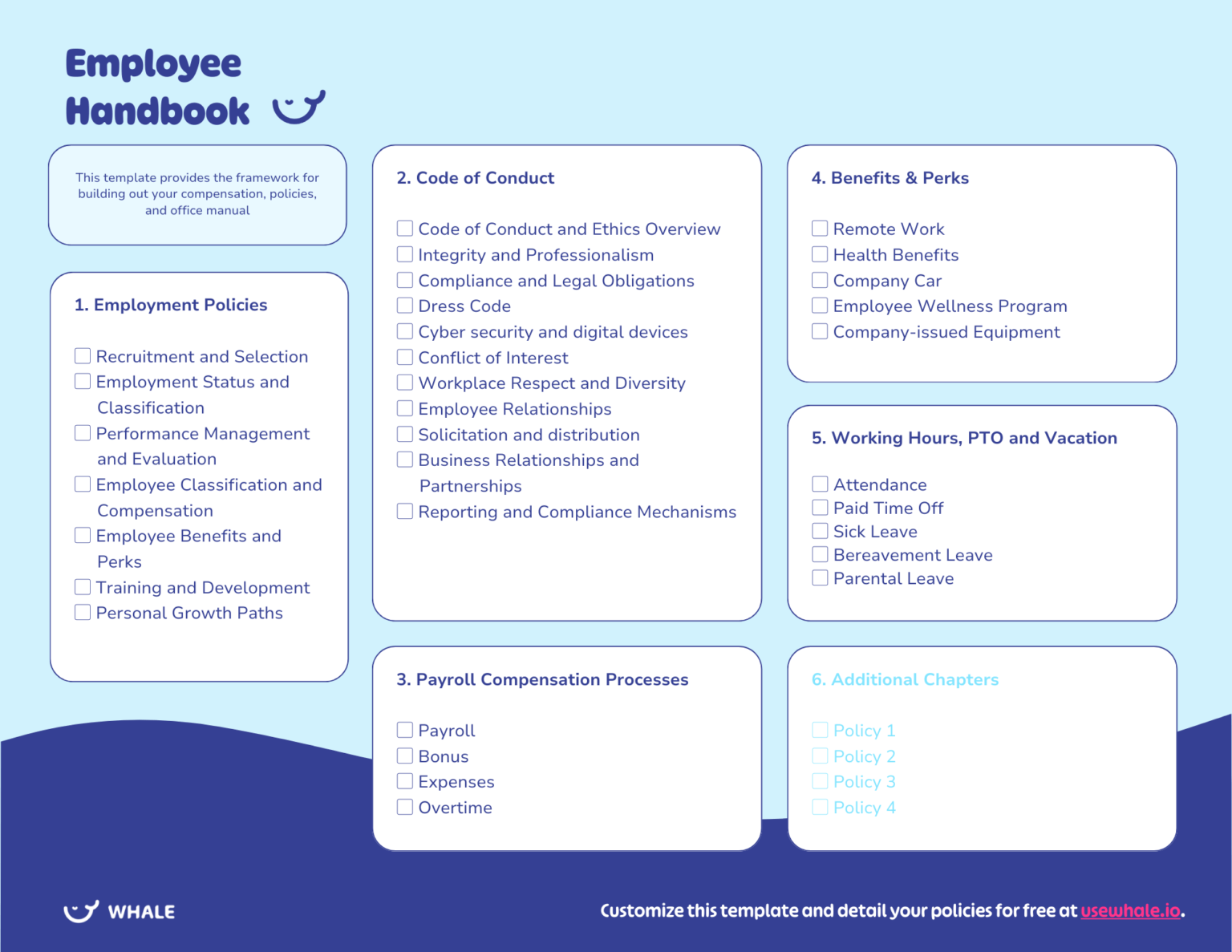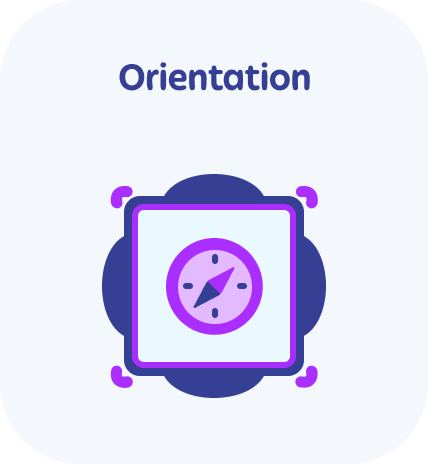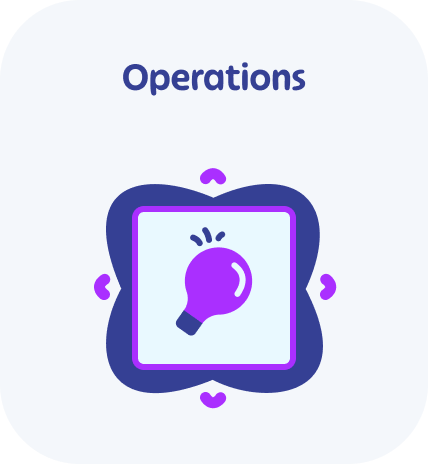The employee handbook is an essential part of any good onboarding program!
Below, we explore how to craft an employee handbook that not only communicates essential information but also engages and inspires your team.
And when you’re done with understanding the basics, you can simply access and customize this employee handbook template in Whale!
What is an Employee Handbook?
An employee handbook is the number 1 Playbook in any organization, serving as a go-to resource for all team members.
It outlines the company’s policies, procedures, and culture, providing guidance on the standards expected of employees and the benefits they can expect in return.
This manual not only introduces new hires to your company’s ethos but also serves as a reference for all employees, ensuring consistency in understanding workplace practices.
Why every business needs an employee handbook?
In its State of the Global Workplace Report 2023, Gallup reports that ONLY “23% of employees are engaged at work.
And that the majority of the world’s employees are “quiet quitting” (6 in 10)!
That’s a staggering amount of people who are not motivated and aren’t contributing their best.
Having an employee handbook not only creates more employee engagement by sharing the purpose and mission of the company but it provides;
Clarity and Consistency
The handbook sets clear expectations for employees, detailing job responsibilities, company policies, and workplace etiquette. It ensures everyone is on the same page, which can significantly reduce misunderstandings and conflicts.
Company Culture and Values
The handbook is a great tool for reinforcing your company’s culture and values. It helps new employees acclimate to your corporate environment and promotes a sense of inclusion and belonging.
Resource for All
Whether it’s a question about leave policies, benefits, or company procedures, the employee handbook is a comprehensive resource employees can rely on, reducing the time management spends on answering common queries.
Carrie Luxem, CEO and HR Training Coach on The Employee Handbook
Use our templates to fast-track your documentation
Customize this template and 100s of others for free in Whale, the fastest way to get your team aligned.
Tips for creating the BEST employee handbook
Just like it’s essential to understand your customer needs when creating your product and service offerings, it’s important to understand your audience when crafting an effective handbook.
It’s not just the information created but it’s HOW you say and communicate it.
Here are some expert tips to guide you through the process.
Make sure you have the essentials
Here are 5 employee handbook essentials you need to include if you’re going to make your handbook a success;
- Purpose
- Values 🏆statement
- Mission 🎯
- The brand story 📚
- Way of doing things, i.e. culture matters 👏
1. Start with a clear structure
Organize the handbook in a logical manner. Start with what’s important; the purpose and mission of your business. Begin with a welcoming message, follow up with core company policies, employee responsibilities, and benefits, and end with legal and ethical policies.
2. Language, tone, and personality matter
Avoid jargon and legalistic language to ensure the handbook is accessible and understandable for all employees. Reflect your company’s personality. If your culture is more informal, let that come through in your writing to make the handbook not just a policy document but a reflection of your workspace.
3. Update regularly
Laws and company policies evolve, so update your handbook annually or whenever significant policy changes occur. This keeps your handbook relevant and compliant with current laws.
4. Get team feedback
Do your team understand your employee handbook? Do they have questions? Do they think anything is missing? You won’t know if you don’t ask.
Employee handbook mistakes to avoid
Before we share the must-haves of a great employee handbook, here are some of the common mistakes that companies often make;
- ❌ Copy-and-pasting the old handbook
- ❌ Getting stuck in the detail
- ❌ Using too much technical jargon
- ❌ Forgetting to update it
Remember you won’t be able to tell your new team member absolutely everything in the employee handbook. That’s what an onboarding process is for and why it often spans 90 days or more.
What should be included in an employee handbook?
The purpose of the employee handbook is to translate the essence of the company, brand, and culture and to get new team members excited about being part of it all!
Mega brands like Netflix and Hubspot are famous for their employee handbooks and onboarding programs! One might even go as far to say as it’s their online and publicly visible handbooks that attract the world’s best talent!
Typically these handbooks include elements such as;
- Purpose statement
- Values
- Mission
- The Company Story
- Way of doing business
- Fun stuff – Yes, we even have our Spotify Playlist in ours!)
How to structure your employee handbook?
The entire structure of your employee handbook is going to be determined by the size and culture of your company. We deemed it not necessary to have all of the elements below because we have a small team but also because we believe we shouldn’t have to talk about things like disciplinary procedures.
We have a pretty straight culture and always address issues in meetings. So instead, we chose to talk about meeting schedules and objectives in our handbook.
You may or may not choose to have ALL these elements in your employee handbook;
Introduction:
- Welcome message
- Company mission, vision, and values
- About the company
Employment Policies:
- Equal employment opportunity
- Diversity policies
- Attendance and punctuality
- Hours of work
Code of Conduct:
- Dress code and appearance
- Personal conduct and professionalism
- Use of company property and resources
- Social media and internet usage
- Confidentiality and data privacy
Compensation and Benefits:
- Payroll schedule and procedures
- Overtime policy
- Vacation, sick leave, and other time-off policies
- Health insurance and other benefits
- Retirement plans
Performance and Conduct:
- Performance expectations and evaluations
- Promotion and advancement policies
- Disciplinary process and procedures
Safety and Security:
- Workplace safety guidelines
- Emergency procedures
- Security measures (e.g., access control, data protection)
Communication:
- Reporting lines and organizational structure
- Communication channels (e.g., email, meetings)
- Employee feedback and suggestion process
Training and Development:
- Orientation and onboarding process
- Training and development opportunities
- Continuing education support
- Professional growth and career development
Legal and Regulatory Compliance:
- Employment laws and regulations
- Family and medical leave
- Worker’s compensation
FMLA (Family and Medical Leave Act) policy (if applicable) - ADA (Americans with Disabilities Act) policy (if applicable)
How to get your team to read the employee handbook?
How do you create an employee handbook that EVERYONE wants to read?
Include rich media and switch your mindset from rules to entertainment. It works for Netflix; it’ll work for you!
- Make It Engaging: Use a mix of formats like bullet points, infographics, and even playful anecdotes to make the handbook interesting and engaging.
- Share It Properly: Don’t just hand it over; have a session where you walk new employees through the handbook, highlighting key sections and why they matter.
- Incorporate it into Onboarding: Make reading the handbook a part of the onboarding process. Use quizzes or interactive content to test knowledge and engage new hires with the material.
- Offer Incentives: Consider offering incentives for employees who show they’ve understood the handbook. This could be through quizzes, a discussion session, or even a small reward.
FAQs on an employee handbook
How often should we update our employee handbook?
Ideally, review and update your handbook annually and with every major change in employment law or company policy.
Should small businesses also have an employee handbook?
Absolutely! Even if you only have a few employees, a handbook can clarify expectations and save you from potential legal trouble.
Can I just download a hanbook template and use it?
The short answer is yes, BUT we would say it’s important to customize the content to reflect your specific business needs and local laws if you want team members to take it seriously.
How detailed should the handbook be?
It should be detailed enough to cover all essential policies and common scenarios but concise enough that employees aren’t overwhelmed with information. Remember your handbook forms part of your onboarding process, so you want team members to be excited about it.
Use our templates to fast-track your documentation
Customize this template and 100s of others for free in Whale, the fastest way to get your team aligned.







